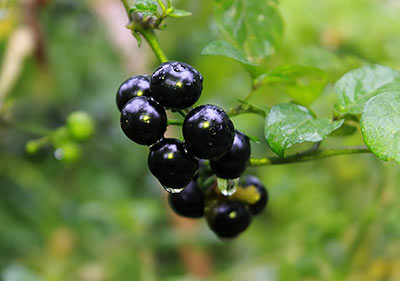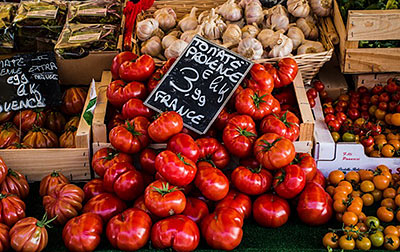Articles
Enchanted Nightshades
The Solanaceae family, also known as the nightshades, is a diverse and significant group of plants that includes many of our favourite edible species. This family is renowned for its variety of fruits, vegetables, and spices, which are staples in cuisines around the world.
Characteristics of Solanaceae

Solanaceae plants are known for their varied growth habits, including herbs, shrubs, trees, and vines. They are typically characterised by:
Flower Structure: Solanaceae flowers usually have five petals, five sepals, and five stamens. The petals often form a tubular or funnel shape.
Leaves: The leaves of nightshades are often alternate and can be simple or compound, usually with a characteristic strong odour when crushed.
Fruit: The fruits of Solanaceae can be berries or capsules, many of which are edible and important in agriculture.
Notable Members of the Solanaceae Family
Tomato (Solanum lycopersicum): Originating from South America, tomatoes are now a global staple, used in salads, sauces, soups, and countless other dishes.
Potato (Solanum tuberosum): Native to the Andes region, potatoes are one of the world's most important food crops, consumed in numerous forms such as mashed, fried, and baked.
Eggplant (Solanum melongena): Known for its unique texture and mild flavour, eggplant is a key ingredient in dishes like ratatouille, moussaka, and baba ghanoush.
Peppers (Capsicum spp.): This group includes capsicum (or bell peppers), chilli peppers, and paprika.
Goji Berry (Lycium barbarum): Hailed for its health benefits, the goji berry is consumed as a superfood in smoothies, snacks, and teas.
Gooseberry (Physalis peruviana): Also known as ground cherry, goldenberry or Cape gooseberry, this tangy and sweet fruit is rich in vitamins A and C, and often used in desserts, jams, and salads.
Tobacco (Nicotiana tabacum): Beyond its notorious use in smoking products, tobacco has historical significance and has long been used in traditional medicine.
Culinary and Health Impacts
The Solanaceae family provides a wealth of nutritional benefits. Tomatoes and peppers are rich in vitamins A and C, antioxidants, and fibre. Potatoes are an excellent source of carbohydrates, potassium, and vitamin C. Eggplants provide dietary fibre, vitamins, and minerals, while chilli peppers contain capsaicin, known for its pain-relieving properties.
However, it’s worth noting that some members of the Solanaceae family contain alkaloids that can be toxic in large quantities. For example, green potatoes contain solanine, which can cause gastrointestinal distress if consumed in high amounts. Despite these concerns, the edible members of this family are generally safe and highly nutritious when properly prepared.
Medicinal Uses and Toxicity
Many Solanaceae plants have been used in both traditional and modern medicine. Belladonna (Atropa belladonna), also known as deadly nightshade, contains hyoscyamine, atropine and scopolamine, which are used for their anticholinergic properties in modern medicine and by optometrists to dilate pupils during eye examinations. These potent alkaloids can also relieve pain and nausea, treat muscle spasms, and even manage certain heart conditions under careful medical supervision. Capsaicin from chilli peppers is widely used in topical creams to relieve pain and inflammation and improve circulation.
Myths and Lore Surrounding the Solanaceae Family

The Solanaceae family is steeped in myth, folklore, and historical intrigue. Many of its members have been both revered and feared, often associated with witchcraft, medicine, and mysticism. Let's delve into the fascinating myths and lore that surround some of the most intriguing plants in this family.
Belladonna (Atropa belladonna)
Commonly known as deadly nightshade, belladonna has a storied and dark history. Its name, "belladonna," means "beautiful lady" in Italian, stemming from its historical use by women to dilate their pupils, which was considered attractive. However, belladonna is highly toxic and has been used as a poison throughout history.
In medieval Europe, belladonna was believed to be an ingredient in witches' flying ointments, concoctions that supposedly allowed witches to fly and perform magical feats. The plant's hallucinogenic properties, due to its tropane alkaloids, likely contributed to these beliefs. Just to confuse things further, deadly nightshade is not to be confused with black nightshade berry (Solanum nigrum), often overlooked due to its toxic relatives, is actually edible when fully ripe and is traditionally used in some cultures for its nutritional and medicinal properties.
Mandrake (Mandragora officinarum)
Mandrake roots have a long history of myth and superstition due to their human-like shape.
One of the most famous myths is that mandrake roots scream when pulled from the ground, killing anyone who hears the sound. To avoid this, it was said that people would use a dog to pull the plant up, ensuring the human was out of earshot. Mandrake was believed to have powerful magical properties. It was used in love potions and as a talisman to bring good fortune and ward off evil spirits. In some legends, mandrake could bestow fertility or act as a protective charm.
Datura (Datura stramonium)
Known as moonflower, devil's trumpet, jimsonweed or thorn apple, Datura has been both revered and feared for its potent psychoactive properties. Indigenous cultures in the Americas used Datura in spiritual and shamanic rituals to induce visions and communicate with the spirit world. Its use was often restricted to shamans or priests due to its dangerous hallucinogenic effects. Like belladonna, Datura was thought to be used by witches in their ointments and potions. Its mind-altering properties contributed to its reputation as a plant of sorcery and magic.
Brugmansia (Brugmansia spp.)
Known as "angel's trumpet," as the large trumpet shaped flowers hang down as if from the heavens, opposite to Datura's devil's trumpet which reach upwards from the fiery depths of the underworld. In South American indigenous cultures, Brugmansia has been used in shamanic rituals as a means to connect with the spirit world. The plant's powerful hallucinogenic properties were believed to open gateways to the divine and provide protection against evil spirits. Despite its beauty, Brugmansia is also associated with death and danger due to its toxicity. Legends tell of its use in rites of passage and vision quests, where shamans would guide individuals through transformative experiences, often involving near-death visions or encounters with the spirit world. Just getting a little too close to this enchanting fragrant plant can send your head in a spin.
Tobacco (Nicotiana tabacum)
While tobacco is now commonly most associated with smoking, it has a rich history in the mythology and rituals of Native American cultures. Tobacco was considered sacred and used in ceremonies, offerings, and as a means of communication with the spiritual realm. It was believed to carry prayers to the gods and ancestors. In many Native American cultures, the smoking of a peace pipe, often filled with tobacco, was a vital ritual in treaty-making and diplomacy, symbolising peace and friendship.
Henbane (Hyoscyamus niger)
Henbane has a history of use in magic and medicine, often with dark connotations. Henbane was a common ingredient in magical potions and brews, used to induce trance-like states or hallucinations. Its association with witchcraft and sorcery is well-documented in European folklore.
The ancient Greeks used henbane in the cult of Apollo. The Pythia, or Oracle of Delphi, may have inhaled the smoke of burning henbane to enter a prophetic trance.
The Solanaceae family is not only important for its agricultural and culinary contributions but also for its rich tapestry of myths and lore. These plants have woven their way into the fabric of human culture, embodying both the beneficial and the dangerous, the sacred and the profane. Their storied past continues to fascinate and inspire, highlighting the deep connection between humanity and the natural world.

The seeds of the edible members of the nighshade family are the perfect thing to get a jump on as spring approaches, starting them on a warm windowsill or bright protected nook, readying them for their place in your garden as the weather warms.
What tomato, eggplant, capsicum and chilli pepper seeds are you getting started this spring? Maybe some cape gooseberr, while you're at it?



